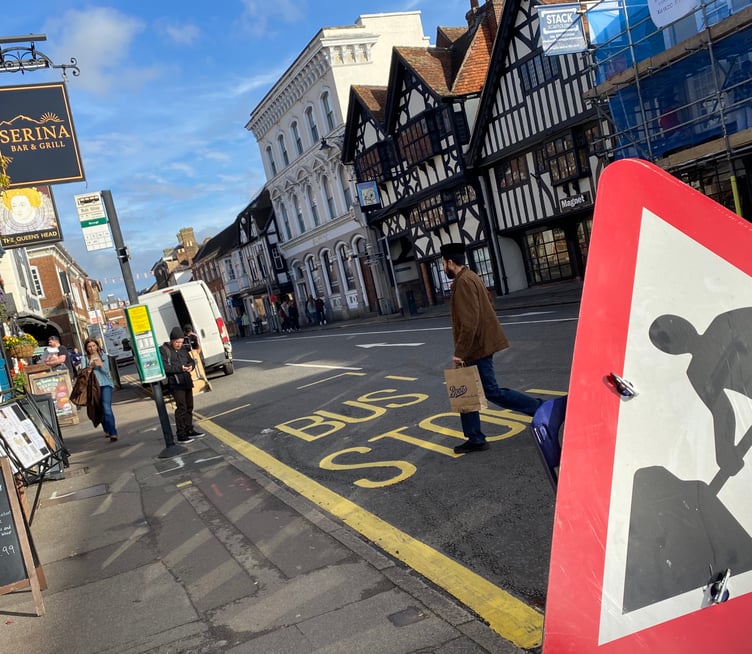Infrastructure heading inexorably for Armageddon
The welcome reopening of Downing Street after three months marks the end of the easy first stage of the Farnham Infrastructure Plan (FIP). Though not yet complete, the result must be seen as a success. Northbound traffic is flowing again, even if the daily jam has shifted to the top of Castle Street and into the Borough. Stage two, long expected to be difficult, will tighten the choke-point by the Royal Deer.
Cllr Catherine Powell now advises (Herald, October 30) that a full closure of South Street and Union Road — together with further restrictions in the Borough between Castle Street and the Deer — is “unavoidable”. Her accompanying map, however, did little to improve public understanding. Many readers have remarked that its captions and layout only add to the confusion. If such drawings reflect the visual aids provided to work teams, one wonders what this says about the project’s management. It also raises the question of why the Project Lead abruptly left the council.
Still, greater disruption lies ahead, and Farnham must brace itself. But we should not lose sight of the wider issue. The FIP was always a stop-gap — a “do something affordable now rather than nothing” compromise — ahead of tackling the real elephant in the room: Farnham’s vast and growing traffic problem. Securing funding for a proper solution is increasingly urgent, not least with the possibility of Woking Council’s financial collapse in 2027 placing even more strain on central and local budgets.
Farnham’s traffic problems are centuries old. Positioned on the Pilgrims’ Way, the town had become, by the 13th century, an important staging post between Winchester, London and Canterbury. It flourished later as a coaching and market town, but remained linear in layout: Castle Street to the north, St Andrew’s Church and the markets to the south, and Downing Street as the only route south across the River Wey. Livestock travelled along green lanes whose names survive today.
Until the late 19th century Farnham had no need for a north-south transit route, and access through Farnham Park and Castle grounds was unlikely to have been encouraged. A compromise solution — South Street, Union Road and later Longbridge — created a route over the ford, but the town centre was then cut off again by the railway, and later by the by-pass. The result endures: Farnham is divided by two modern barriers with just three crossing points, one of them a level crossing.
For half a century, the town has searched for ways to handle growing congestion. Solutions have been proposed and occasionally researched. Demolishing historic buildings — once suggested — was rejected as Farnham moved towards conservation, especially after the loss of East Street’s 16th and 17th century houses to the now-derelict Woolmead.
Traders have long been wary of measures that reduce vehicle access. Yet the recent closure of Downing Street showed that footfall can remain steady while drivers still reach Central Car Park. By contrast, the six-month closure of West Street during the Coxbridge works sent shoppers elsewhere, as motorists bypassed Farnham entirely. If similar disruption returns, it seems fair to argue that developers should compensate for economic damage — a point worth considering ahead of the Waverley Lane project, which will heavily affect the level crossing, one of our few north-south links.
The best long-term solution has always been a fully engineered western by-pass from Castle Hill to Coxbridge, with a secondary option for a relief route through the Upper and Lower Hart car parks to West Street. Both depend on access from Castle Hill. The Coxbridge development may now have made the preferred route unworkable.
Two decades ago, as a private citizen, I submitted a proposal to Farnham Council for a five-storey underground car park beneath the railway station car park, offering 1,000 spaces, garden space at ground level, an emergency helicopter pad and a westbound exit to the by-pass. It included a free 24-hour park-and-ride loop around the town. Waverley Borough Council reviewed my costings and confirmed that the 2005 figure of £14m, including contingency, was reasonable.
My idea was later partly absorbed into Waverley’s plan for upper-deck car parks at several stations, including Farnham. That scheme has eased peak-time pressure post-Covid, but it has not reduced traffic entering the town. If the western by-pass is no longer viable, a similar “northern” car park in the Upper Hart, with access from Castle Hill, could revive part of the original FIP vision.
Such measures would allow visitors, shoppers and businesses to reach Farnham without bringing all their vehicles into the centre. That, in turn, could finally allow pedestrianisation — and the freeing of sites such as the Woolmead and Central Car Park for green space from which the town’s heritage buildings might be enjoyed in calmer surroundings.
But time is short. Our councillors, at all levels — whatever other political anxieties may distract them — must seize this last opportunity to act. The sums involved are trivial compared with what the mismanaged affairs of Woking may yet cost every one of us.
Dr Clarence Eng, MA (Cantab.), MSc, MA (Lond.), PhD
Aveley Lane
Farnham
The kindness of others
On Friday, October 24 at about 6.15pm, I unfortunately tripped and fell heavily in East Street, injuring my head, left shoulder, right wrist and both knees.
Many people stopped to help me, including two young women and two young men who kindly restored my dignity by removing leaves and debris from my hair. A very kind gentleman also helped me to my feet and went out of his way to drive me home.
Because of the shock and pain, I did not manage to thank everyone at the time. Through this letter, I want to express my sincere and lasting gratitude to all who came to my aid. I hope they may read this and know how grateful I am — and how heartening it is to be reminded that good Samaritans still exist.
Susan Wheeler
Osborn Road
Farnham




.jpeg?width=209&height=140&crop=209:145,smart&quality=75)
Comments
This article has no comments yet. Be the first to leave a comment.